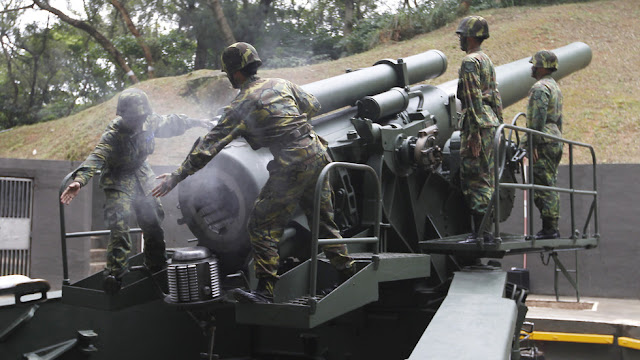US-Taiwan Arms Deal Undermines Not Upholds the Island’s Security
August 14, 2021August 14, 2021 (Joseph Thomas - NEO) - Twenty years ago, Taiwan counted the United States as its biggest export market, with Hong Kong and Japan in second and third place. Japan and the US also accounted for Taiwan’s largest import partners.
Twenty years later, the numbers tell a different tale. China by far is now Taiwan’s largest import and export trade partner, and counting it together with a much more integrated Hong Kong, its trade nearly dwarfs all other trade Taiwan has with the entire West.
If money is power, the flow of trade between Taiwan and the mainland represents an increasing amount of power to shake Washington’s grip on the island territory.
In this context, headlines like, “US government clears $750 million artillery sale to Taiwan,” from Defense News look less like Washington making headway and more like a futile attempt by Washington to instead play “catch-up.” It is catching up in the only way the US appears able to, through a series of manufactured threats and the promise of protection through arms sales to defend against them.
The defense capabilities offered to Taiwan through this most recent deal would make little difference “if” a war ever broke out between the Chinese mainland and its Taiwan territory. But that’s only “if.” In reality, the economic integration of Taiwan with the mainland is long underway and Washington’s brand of geopolitics, playing arsonist and firefighter, can only delay this inevitability.
The Defense News article notes:
The US State Department has cleared the sale of self-propelled howitzers and GPS-guided kits for artillery shells to Taiwan, marking the first such approval for the country’s self-ruling by the Biden administration.
The Defense Security and Cooperation Agency, or DSCA, announced the approval on Wednesday afternoon for Taiwan to acquire 40 M-109A6 Paladin 155mm self-propelled howitzers with associated equipment and support. The estimated cost of the potential sale is $750 million.
Large expenditures on “defence” against Taiwan’s largest trade partner is obviously illogical and wasteful. It is the sort of policy one could expect Taiwan’s politicians to pursue in support of US foreign policy objectives, rather than in support of Taiwan’s actual own best interests.
The arms deal has only created pressure between both Washington and Beijing, and the Chinese mainland with its Taiwan territory.
Even the US Doesn’t Recognize Taiwan as a Country
Officially, Taiwan is not a country. Not even Washington recognizes it as one. To illustrate this, for example, the US does not have an embassy in Taiwan. Instead it has what it calls the “American Institute in Taiwan.” This game of officially recognising the “One China” policy where Taiwan is recognised as part of a single China, while “unofficially” undermining the policy through de facto embassies, arms deals and America’s latest tip-toeing toward diplomatic relations with and recognition of Taiwan’s politicians, reveals the true source of tensions between Taiwan and the mainland.
Talks publicly available through the National Committee on US-China Relations feature US policymakers and politicians openly boasting about this two-faced approach to Beijing and the undermining of mainland-Taiwan relations.
Thus the “Taiwan question” is a pawn used by Washington for advancing US foreign policy objectives and in particular regard to encircling and containing China. Little to no regard at all is given to what is actually best for Taiwan.
This is why US policy toward Taiwan continues to focus on undermining positive communication between Taiwan and its largest most important source of economic prosperity, mainland China, as well as giving Taiwan weapons to point at its most important source of economic prosperity.
The diligent work of the US to make political dialogue between Teipei and Beijing reflect the ongoing economic integration of the island territory is at best a delaying tactic meant to complicate reunification and possibly provide a potential flashpoint to derail it altogether. Of course, in either scenario Taiwan loses.
What’s Next?
Washington continues to push the narrative of an impending invasion from the mainland. The obvious goal of US foreign policy is to continue pushing, no matter how artificially and contrary to Taiwan’s best interests, toward a declaration of independence by Taiwan’s political administrators no matter how detached from reality such a declaration would be.
It is a repeat of US attempts to maintain Western influence over Hong Kong before US-backed protests finally petered out and the National Security Law effectively ended them for good.
The notion of Hong Kong becoming an “independent” territory was absurd. Yet the US managed to convince thousands of mostly young Hong Kong residents to fight in the streets against police, destroying their city, attacking their neighbours and damaging the economy in the process. In the end, many ended up in jail, paying the consequences of playing a role on behalf of Washington who used then discarded the opposition.
The same process is happening in Taipei regarding pro-independence politicians. The island is much larger than Hong Kong, possessing many of its own institutions including a military regardless of how outmatched its is by its mainland counterparts, and thus possesses the capacity to draw out Washington’s Hong Kong-style strategy much longer and prolong the setbacks Taiwan will suffer in the process.
But time is on Beijing’s side. Even a “declaration of independence” would not necessitate an “invasion” from the mainland. China can simply wait until Taiwan’s people feel the pain of US-induced “independence” and the stark contrast between political fantasies and both legal and economic realities.
Joseph Thomas is a Bangkok-based geopolitical researcher and writer, especially for the online magazine “New Eastern Outlook”.

